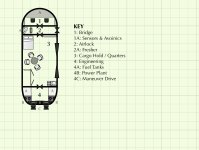So I've been looking at this
Rift X-Courier and wondering about possible alternative private uses for such a starship (aside from the obvious commercial applications) and one of the first ideas that (re)surfaced was the idea of having a sort of Yacht(-ish)/Safari(-ish) type of alternative configuration courtesy of the 80 ton internal cargo bay and the external cargo capacity (interplanetary and interstellar).
The basic idea would be to use "standard" 20 ton containers, which the 80 ton internal cargo bay could contain 4 of during atmospheric entries. In this case, each of these 20 ton containers would be full on configuration: 4 type small craft hulls with no bridge, computer, drives or fuel (MCr 1.2 each) so they can be external to the
Rift X-Courier in space without a problem.
The contents of each 20 ton container could vary, such as a simple 5 stateroom setup (20 tons, MCr 2.5) or a multi-vehicle berth "pod" or whatever configuration was desired.
Looking back at my
Spinward Yacht design that I posted months ago as part of the
200 ton Yacht Design Contest in this forum, I realized that all of the main component functional features of that earlier design could be replicated with a
Rift X-Courier plus 20 ton containers design format.
Rift X-Courier: MCr 92.748 (first in class) / MCr 74.1984 (volume production)
5 stateroom 20 ton container (each): MCr 3.7 (first in class) / MCr 2.96 (volume production)
"empty" 20 ton container: MCr 1.2 (first in class) / MCr 0.96 (volume production)
What you basically do is you buy the starship (MCr 74.1984 in volume production), 3 of the 5 stateroom 20 ton containers (MCr 8.88 in volume production) and 1 "empty" 20 ton container (MCr 0.96 in volume production) for use as a vehicle bay and additional cargo storage space. Grav vehicles would be most appropriate for TL=11 and could be one or more air/rafts (4 tons, MCr 0.6 each), g-carriers (8 tons, MCr 1 each) and or speeders (6 tons, MCr 1 each). Another option for the "empty" container would be to include auditorium, laboratory and/or workshop spaces (4 tons, MCr 0.5 each), which could be anything from a trophy room to a specimen analysis/storage lab to vehicle maintenance to kitchen facilities for cooking elaborate meals and fine cuisine (let your imagination run rampant with the range of possibilities!).
Net result is 15 staterooms and 20 tons of vehicle berthing inside of four 20 ton "standard" containers that are all spaceworthy and can fit into the 80 ton cargo bay of the
Rift X-Courier for landings through atmosphere.
The contents of those four 20 ton "standard" containers could be assigned as follows:
- Container 1 (passenger)
- 4 High Passengers (including a presumably noble owner/host)
- 1 Steward (serving 8 high passengers)
- Container 2 (passenger)
- 4 High Passengers
- 1 Medic (required for up to 120 passengers)
- Container 3 (security)
- 1 Military Attaché officer (assigned to the noble owner)
- 4 Marines (ship's troops assignment as a fire team, can also crew any vehicles)
- Container 4 (other)
- Vehicle berth(s)
- Auditorium(s)
- Laboratory space(s)
- Workshop(s)
Ordinarily marines aboard would be assigned 2 ton cabins rather than 4 ton staterooms, much like gunners, but giving them larger quarters also gives them additional room to stow and maintain their military issue gear and equipment inside their quarters. Also, since they are all quartered within their own 20 ton container, that ought to help with security by compartmentalizing the passenger spaces away from the quarters for the marines.
Note that for "safari" style expeditions, all 4 containers could be offloaded from the internal cargo bay of the
Rift X-Courier onto a world surface (almost ANY world surface, since the containers have "ship rated" hulls) and string them together in a daisy chain (linear or closed square) as an outpost for any expeditions that could last weeks at a time "with all the comforts of home" but not reliant upon the starship being present (so the ship and the crew can be attending to other business).
The price tag for this extra capability?
An extra MCr 9.84 in volume production (MCr 12.3 when not in volume production), not including the cost of any vehicles or auditorium/laboratory/workshop spaces installed into the "empty" container 4 as shown above.
That would mean that a Rift X-Courier/Yacht would cost MCr 105.048 (first in class) or MCr 84.0384 (volume production) ... not including vehicles and/or auditorium/laboratory/workshops when exercising the "military security" aboard option.
Other alternative configurations also exist, such as a laboratory explorer ship, in which container 3 is entirely devoted to laboratory space and container 4 is a mix of vehicle(s), a workshop for vehicle maintenance and additional laboratory space. If fewer than 8 high passenger (scientists) are needed for an expedition, then container 1 can also be devoted to laboratory space, downgrading accommodations in container 2 from high passenger to middle passenger accommodations for the 4 scientists and 1 medic.
In addition to all of the above, the
Rift X-Courier would be capable of transporting all 4 container modules either internally or externally.
When transporting the four 20 ton containers internally, both the containers and the starship can enter atmosphere and safely make planetfall to land the containers onto the surface of almost any world. Range will be limited to 1 Jump-2 or 2 Jump-1 on internal fuel tankage only.
When transporting the four 20 ton containers externally, the
Rift X-Courier has a drive performance of Jump-1 and Maneuver-1, consumes 27.4 tons of fuel per Jump-1 and another 1.1 tons of fuel per 8 days ... while having a 43+80=123 ton total fuel capacity with the collapsible fuel bladder fully loaded. This is sufficient fuel for 4 Jump-1 (4*28.5=114 tons) leaving 9 tons of fuel remaining, which is sufficient for ~65 days of maneuvering at 2G at the destination before fuel is exhausted (which hopefully will be enough to secure wilderness refueling).
This performance profile makes "long range" (for Jump-2 at TL=11) travel of 4 parsecs (one way) possible while carrying "expeditions" to interstellar locations with the capacity to "leave them there" for a season (or few) with the contents of the 20 ton containers to sustain them until the (or another)
Rift X-Courier starship arrives to retrieve them or resupply the expedition or rotate their members on site. This in turn enables long term surveys and scientific studies at remote locations that would otherwise be inaccessible (or simply impractical) without the capabilities of the
Rift X-Courier. Oh and once the 20 ton containers are offloaded, the starship can tank up on fuel, return the their starting point and ferry
even more 20 ton containers to a destination in order to build up an outpost for much longer term habitation and possibly even settlement (locale depending).
Because ... seriously ... why would you need to have separate purpose built starships for the shipping of goods, passengers and x-mail in a mercantile capacity, nobles in an "official" (or retired) capacity, military special forces for insertion and firebase establishment (think about it), long(er) term scout survey missions, scientific expeditions, deep space fuel cache resupply ... and a whole host of other possible tasks and missions? Why can't you have a single starship that has so much built in versatility that the better question to ask is what CAN'T the ship do when you have a sufficiently creative grasp of the possibilities, rather than what it CAN do?
Why can't you have a starship so capable that the only specialization it "needs" depends on what modules you feel like stuffing into the cargo bay (or "towing" externally) and being able to repeatedly "milk run" those modules to destinations up to 4 parsecs away in support of operations? Let the container modules be specialized, rather than the starship.
And if that doesn't get your Traveller Adventure senses tingling at the possibilities ... perhaps this quote might (emphasis added for context).
A human being should be able to change a diaper, plan an invasion, butcher a hog, conn a ship, design a building, write a sonnet, balance accounts, build a wall, set a bone, comfort the dying, take orders, give orders, cooperate, act alone, solve equations, analyze a new problem, pitch manure, program a computer, cook a tasty meal, fight efficiently, die gallantly.
Specialization is for insects.
— Robert Heinlein,
Time Enough for Love
I agree.












